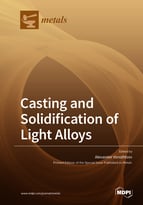Casting and Solidification of Light Alloys
A special issue of Metals (ISSN 2075-4701). This special issue belongs to the section "Metal Casting, Forming and Heat Treatment".
Deadline for manuscript submissions: closed (31 May 2020) | Viewed by 44699
Special Issue Editor
Interests: high-energy materials; high-strength light alloys; metal matrix nanocomposites
Special Issues, Collections and Topics in MDPI journals
Special Issue Information
Dear Colleagues,
The processes of casting and crystallization are defining in the formation of the final properties of light alloys, and optimization of these processes allows improving efficiency of the use and applications of light alloys. The analysis and design of such processes requires special attention. The aim of this Special Issue is to present the latest achievements in technology, including advanced and modern approaches, structure development, and properties of the light alloys.
Investigation of the effect of casting and crystallization on the structure and properties of the resulting light alloys (based on aluminum and magnesium to begin with), and in particular, research connected with detailed analysis of the microstructure of light alloys obtained using various external influences of ultrasonic, vibration, magnetic, and mechanical processing on the casting and crystallization, are welcomed. The use of modern methods of studying the properties of alloys in order to assess the effect of structure on the mechanical and functional properties of light alloys is planned for publication in the Special Issue. Research on the study of introduction of additives (modifiers, reinforcers, including nanosized ones, etc.) into the melt on the crystallization process, the technological properties of casting (fluidity, segregation, shrinkage, etc.), the structure and physicomechanical properties of light alloys are also of interest for this issue. It would be great to find papers that focus on the study of the relations of physicomechanical properties with the defective structure of light alloys and mathematical modeling of plastic deformation of dispersion-strengthening materials. We would like any articles taking both experimental and theoretical (analytical and numerical) approaches, as well as those that consider a combination of these approaches.
Prof. Dr. Alexander Vorozhtsov
Guest Editor
Manuscript Submission Information
Manuscripts should be submitted online at www.mdpi.com by registering and logging in to this website. Once you are registered, click here to go to the submission form. Manuscripts can be submitted until the deadline. All submissions that pass pre-check are peer-reviewed. Accepted papers will be published continuously in the journal (as soon as accepted) and will be listed together on the special issue website. Research articles, review articles as well as short communications are invited. For planned papers, a title and short abstract (about 100 words) can be sent to the Editorial Office for announcement on this website.
Submitted manuscripts should not have been published previously, nor be under consideration for publication elsewhere (except conference proceedings papers). All manuscripts are thoroughly refereed through a single-blind peer-review process. A guide for authors and other relevant information for submission of manuscripts is available on the Instructions for Authors page. Metals is an international peer-reviewed open access monthly journal published by MDPI.
Please visit the Instructions for Authors page before submitting a manuscript. The Article Processing Charge (APC) for publication in this open access journal is 2600 CHF (Swiss Francs). Submitted papers should be well formatted and use good English. Authors may use MDPI's English editing service prior to publication or during author revisions.
Keywords
- light alloys
- aluminum
- magnesium
- additives
- mathematical modelling
- analytical research






